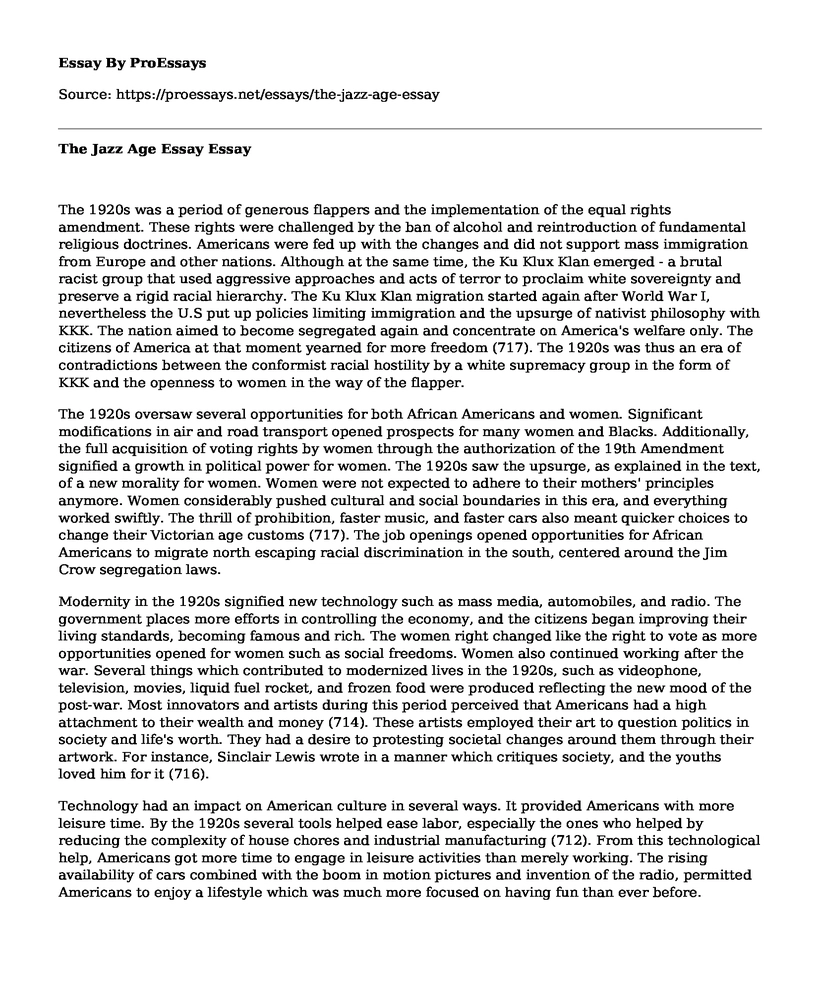The 1920s was a period of generous flappers and the implementation of the equal rights amendment. These rights were challenged by the ban of alcohol and reintroduction of fundamental religious doctrines. Americans were fed up with the changes and did not support mass immigration from Europe and other nations. Although at the same time, the Ku Klux Klan emerged - a brutal racist group that used aggressive approaches and acts of terror to proclaim white sovereignty and preserve a rigid racial hierarchy. The Ku Klux Klan migration started again after World War I, nevertheless the U.S put up policies limiting immigration and the upsurge of nativist philosophy with KKK. The nation aimed to become segregated again and concentrate on America's welfare only. The citizens of America at that moment yearned for more freedom (717). The 1920s was thus an era of contradictions between the conformist racial hostility by a white supremacy group in the form of KKK and the openness to women in the way of the flapper.
The 1920s oversaw several opportunities for both African Americans and women. Significant modifications in air and road transport opened prospects for many women and Blacks. Additionally, the full acquisition of voting rights by women through the authorization of the 19th Amendment signified a growth in political power for women. The 1920s saw the upsurge, as explained in the text, of a new morality for women. Women were not expected to adhere to their mothers' principles anymore. Women considerably pushed cultural and social boundaries in this era, and everything worked swiftly. The thrill of prohibition, faster music, and faster cars also meant quicker choices to change their Victorian age customs (717). The job openings opened opportunities for African Americans to migrate north escaping racial discrimination in the south, centered around the Jim Crow segregation laws.
Modernity in the 1920s signified new technology such as mass media, automobiles, and radio. The government places more efforts in controlling the economy, and the citizens began improving their living standards, becoming famous and rich. The women right changed like the right to vote as more opportunities opened for women such as social freedoms. Women also continued working after the war. Several things which contributed to modernized lives in the 1920s, such as videophone, television, movies, liquid fuel rocket, and frozen food were produced reflecting the new mood of the post-war. Most innovators and artists during this period perceived that Americans had a high attachment to their wealth and money (714). These artists employed their art to question politics in society and life's worth. They had a desire to protesting societal changes around them through their artwork. For instance, Sinclair Lewis wrote in a manner which critiques society, and the youths loved him for it (716).
Technology had an impact on American culture in several ways. It provided Americans with more leisure time. By the 1920s several tools helped ease labor, especially the ones who helped by reducing the complexity of house chores and industrial manufacturing (712). From this technological help, Americans got more time to engage in leisure activities than merely working. The rising availability of cars combined with the boom in motion pictures and invention of the radio, permitted Americans to enjoy a lifestyle which was much more focused on having fun than ever before.
Cite this page
The Jazz Age Essay. (2022, Mar 07). Retrieved from https://proessays.net/essays/the-jazz-age-essay
If you are the original author of this essay and no longer wish to have it published on the ProEssays website, please click below to request its removal:
- Final Exam Assessment: Musical Culture
- My Passion About Playing My Guitar and How It Makes Me Feel - Essay Sample
- Essay Example on Music: Gender and Ranking Roles in a Discriminatory World
- Data-Sharing Soars: Benefits & Risks of Social Media - Essay Sample
- Sex Survey Results: 15K Respondents, 75% Male, 41% Female - Essay Sample
- Essay Example on George Carlin: Exposing the 'Truths' Concealed by Euphemisms
- Paper Sample on Social Media Marketing: Potential Branding Opportunities Worldwide







